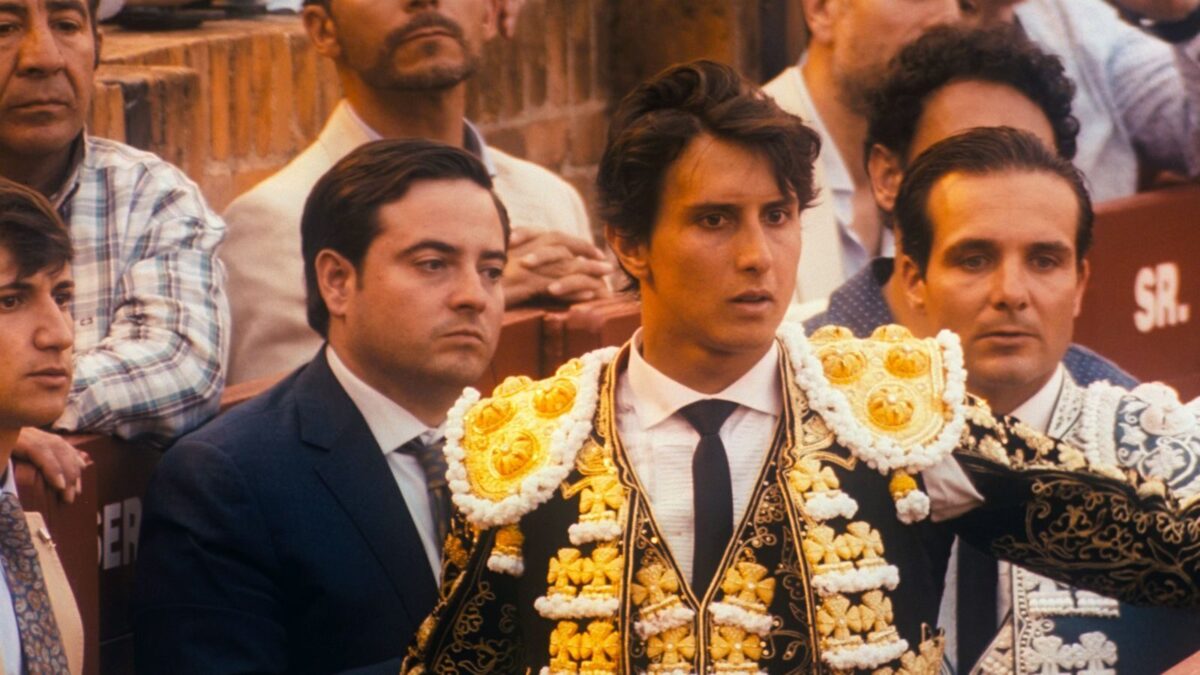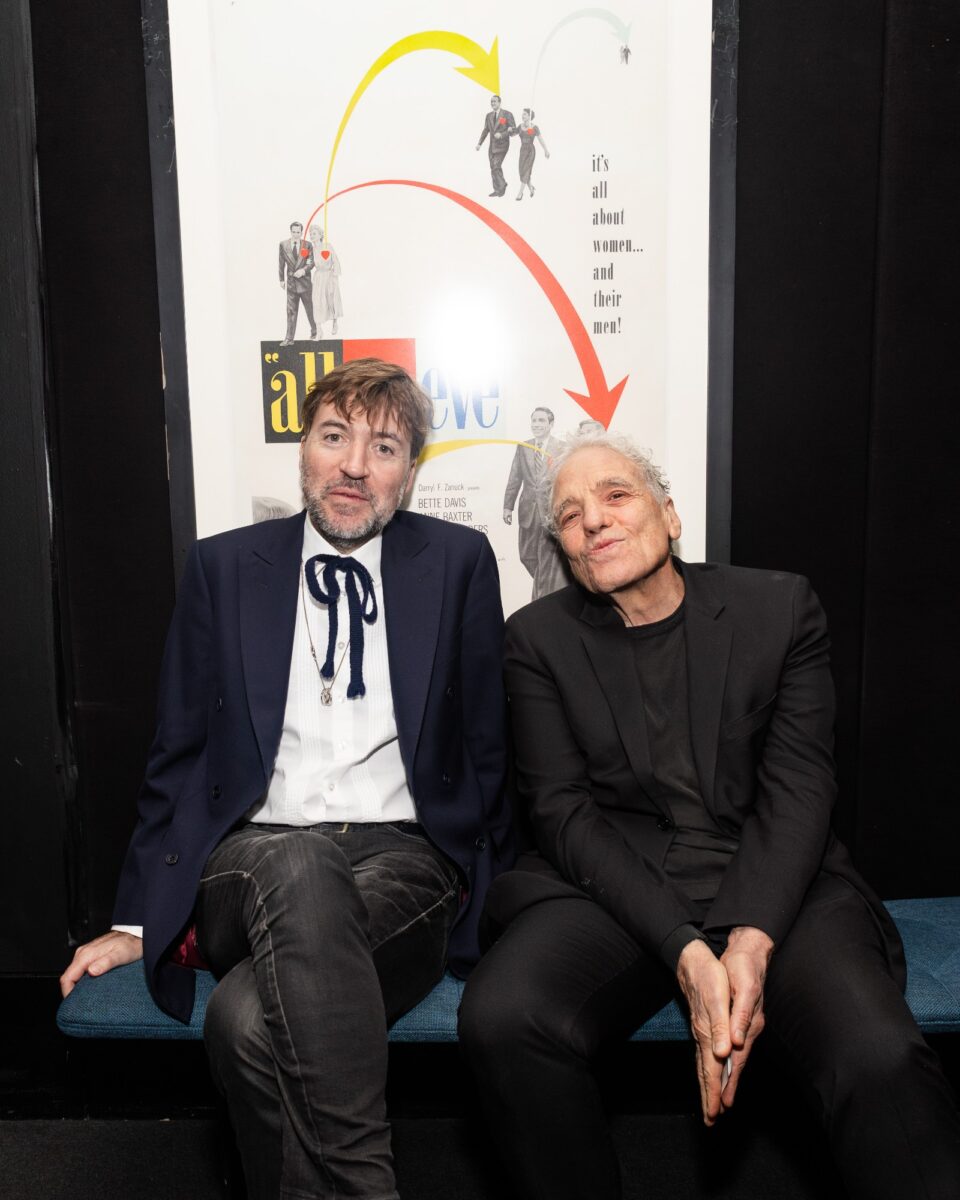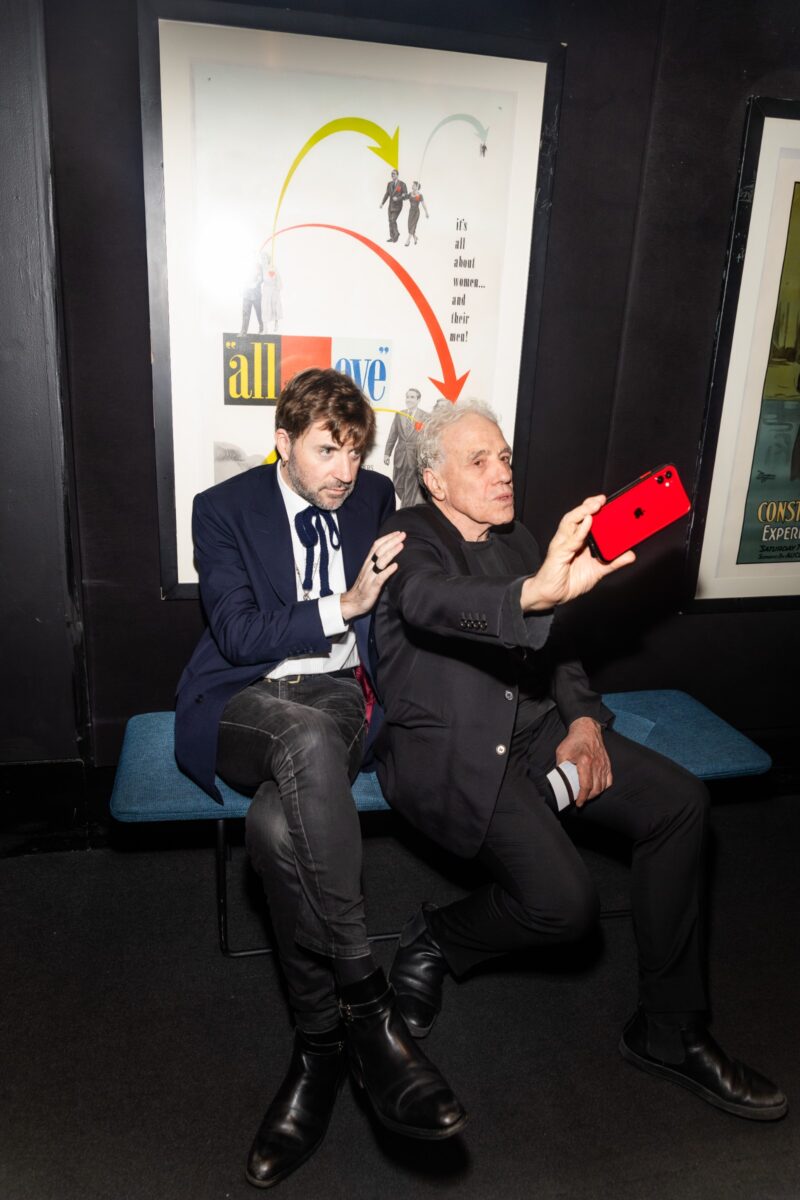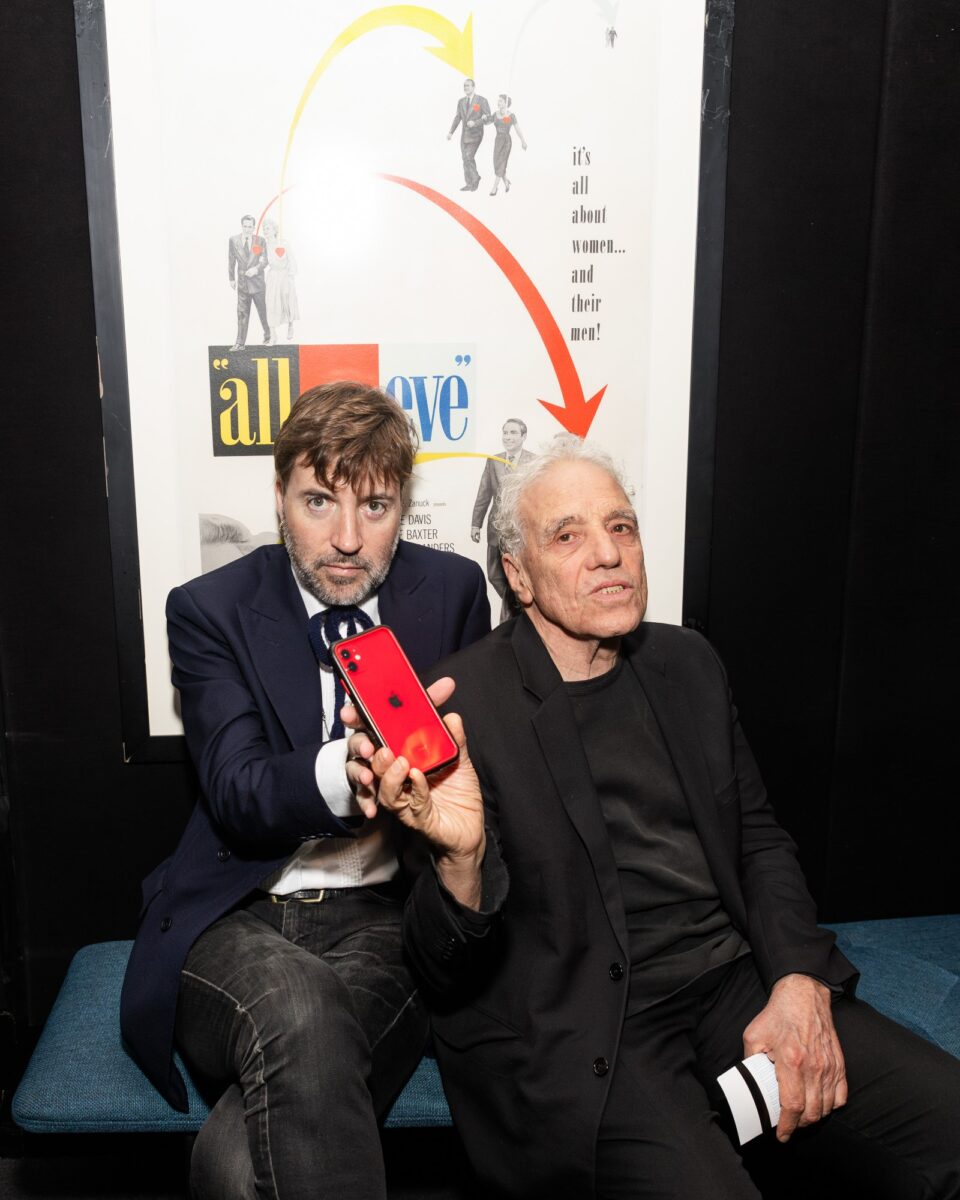Note: This interview was originally published as part of our 2024 festival coverage. Afternoons of Solitude opens in theaters on June 27.
With Afternoons of Solitude, Catalan filmmaker Albert Serra returns to Spain for his first documentary: a bloodsoaked portrait of celebrity bullfighter Andrés Roca Rey and the procession of bulls he slays. Captured in tight framing, Serra’s camera conjures never-before-seen proximity to a frontier of bloodsport. Outside the bullring, Roca Rey floats through limousines and empty hotel rooms: a startlingly somber, almost gentle presence. Without a glimmer of exposition or polemical critique, Afternoons of Solitude builds from an innate curiosity about violence and the seemingly irrational conquests of its practitioners who launch headfirst into the brink of death, risking all for nothing. Though Serra refutes it as a “masculine” performance, bullfighting––with its traditional costuming and theatricality––reveals itself as a strange anachronism: a specter of old values and cultures haunting modern Spain.
I spoke with Serra at the Festival de Nouveau Cinéma in Montreal. We discussed the enigma of Roca Rey, the lineage of bullfighting art, the alleged masochism of bulls, his editing practice, and his planned collaboration with Kristen Stewart.
The Film Stage: I read that Andrés Roca Rey was gored by a 3,000-pound bull and hospitalized just a few days ago.
Albert Serra: I know as much as you do. In the film there’s always a feeling of potential disaster. In fact, he is injured a little bit in the film. At the end of the movie I use an ominous music cue when he leaves the coliseum to underline the idea that something can always happen.
Throughout the movie, there are moments where he just nearly escapes severe injury and seems staggered by the fact that he’s survived. He’s stunned, stammering about luck.
He’s very mysterious. He takes bullfighting as a duty, a tradition. It’s a way of expressing yourself as an artist. But at the same time, I don’t truly understand him. Every documentary is an act of research, an attempt to understand something you don’t know. Going in, I tried to force myself to avoid preconceived ideas of who Roca Rey was. I trust the camera to reveal what our eyes cannot see, what our mind cannot think about. At the end of the movie, I don’t know any more than the audience. Of course I edited the film and shot hours and hours of material. But my perception of Roca Rey is as mysterious as yours. I hardly talked with him except for one brief lunch we had in the middle of shooting. It was just a courtesy lunch.
The story I’ve heard is that, when Hemingway first attended a bullfight, he brought along his pregnant wife, hoping the experience would influence their unborn child. What was your introduction to bullfighting?
I don’t remember; I was very little. Bullfighting was quite common in España, especially in the countryside. But it was different from the bullfighting in the film; it was more provincial, more folkloric. When I first went, I wasn’t especially impressed or frightened, maybe since the bull was smaller. I have more impressions from recent times while I was preparing the film and shooting it. While watching Roca Rey’s fights, I was shocked––I had to cover my eyes from the dread. He was taking so many risks in the arena. People around me were making jokes about me, saying I was too nervous and that I suffered too much for him.
I’m much more moved by the complexity of these bigger shows. It’s proof of what life is. At one point a character tells Roca Rey, “Life has no value!” You have to dismiss life and risk losing it in order to do something great. The conservation of life amounts to nothing by itself. This is the main point of corrida [bullfighting]. Of course, there’s a way to express yourself as a torero [bullfighter], a way of creation. The cinema’s very apt to capture the specific beauty of corrida by linking it to space, time, dance, and movement. I’m a privileged person to have studied corrida with a camera; I’ve seen it in a way almost no one else in history has. Nobody else had the digital technology to capture these images or the sound technology to capture these sounds. Nobody’s shot so many hours of it or studied it in editing as much as me. I’m not saying I’m better than any critic or aficionado, but I have a perspective nobody’s had in the past.

There’s a long tradition of bullfighting art. Hemingway, of course, but also Goya, Manet, Dalí, Francesco Rosi ––
Picasso, Francis Bacon, Bataille, Michel Leiris… sorry.
I was wondering how that artistic lineage informed your own approach.
When I was shooting, it didn’t play a role. When you’re filming, the images are in command; I was there to serve their inner formal logic. You have to work with the images you shoot since what you shoot is life. Camera operators take what they can. They don’t have time to think or search for something beautifully connected to another artist. It’s so difficult already just to pull the focus. But afterwards it’s nice to be part of this tradition. When you see the film you see connections to other works. But only afterwards. Beforehand you can try to think of approaches informed by other artists, but it never works.
For example: I had a beautiful idea drawn from Georges Bataille’s idea of eroticism. I wanted to explore the sexuality of the toro [bull] and link it with women, specifically women watching the show. On rare occasions you see people in the audience buried in the low rows. I thought of hiring an actress, planting her there, and controlling her reactions. But we never did this. There’s a beautiful image when one of the toros is dying and Roca Rey presses his knee down on it. The image reminds me of some drawings, and even a specific painting by Picasso––it’s the same contortion. However, this wasn’t an influence.
Most of the classic bullfighting paintings (like Manet or Goya) take on the perspective of an observer from the crowded sidelines. In your film, you don’t show us anything much above the arena walls, and the framing revolves mostly around medium shots and close-ups.
From the very beginning, I also wanted to make the toro a subject. There’s a lot of shots of the toro looking into the camera, or at least in its direction. My film lets us look frontally at the toro for the first time. Usually in bullfighting depictions, the toro is an object of our regard––or at least the toreros. It’s just something moving; it never confronts or looks at you. During fights, the torero learns much from the eyes of the toro, particularly the movement of its eyes. It’s a useful tool for information to understand its character. Nobody ever thought you could be so immersed in the middle of the arena––so close to the toro, so close to the torero, so close that you could adopt this point of view.
The movie’s first scene ends with the toro peering right into the camera. There’s then a match cut to Roca Rey gazing forward in parallel framing.
Yes! We also see this in the arena plenty of times. I think this point of view is very moving. The movie’s called Afternoons of Solitude, but it’s not only the solitude of the torero, but also the solitude of the toro. When you deal with bullfighting, you deal with the toro as a victim of physical suffering; you’re trying to humanize the toro. But there are many theories about the toro’s suffering. The wild toro is the only animal that fights back. When it’s punished, it keeps on attacking. If you kick a lion, it goes away. Try it with an elephant! If you put some pain on him, he will go away! Same with a bird! Perhaps they will fight back initially, but if you keep beating them, they will escape! There’s no other animal that enjoys suffering except the toro.
In Espagnol we have a beautiful sentence that translates to: “the bull’s energy grows with the punishment.” The toro is the only one who keeps fighting. It’s something explained scientifically through proteins or endorphins that distinguish it from other animals. For this reason, genetic selection is so important; it’s why bulls’ testicles are often crushed as calves.
Albert Serra and Abel Ferrara at the 62nd New York Film Festival. Photos by Mettie Ostrowski.
It seems that a torero like Roca Rey has almost the same impulse: a devotion towards expenditure in spite of self-preservation.
Yes, he aims to fight until the end and give all energy to his duty. For this reason he’s always risking himself to the maximum. A lot of toreadors will never make a great day with a toro, perhaps because it’s acting unpredictable or it won’t push the way they want. They’ll perform a bit mechanically, they just want to kill. But not Roca Rey. He tries to squeeze every toro to its maximum. He does this even with the bad ones.
He’s a celebrity who’s famous for his bravado and his masculinity–
Well, it’s not masculinity. In the dialogues everyone’s praising his balls, his balls, his balls. But I see it as humor or caricature. But most of his movements are feminine. Even in the moment of killing, it’s a calculated movement. It’s not like… [Grunts]. No, you have to do this and this. [Gestures gracefully] It’s hard to always fool the toro. To fool the toro you need a feminine sensuality of movement; you can’t approach it frontally. That’s not even to mention his costume or the posturing of his body. At the end, perhaps there’s a lesson of masculinity here: it’s about fighting until the end.
There’s also a lot of homoeroticism between some of the men, like the scene where Roca Rey’s squire hoists him up to get him into his pants…
There’s enough there that it’s undeniable, but I thought it would appear more! Still, we learn the truth from images. You cannot project your desire or your ideas onto images, especially in documentaries. If you have your own ideas about people fighting, you make a fiction.
You’ve talked about how you molded the film’s structure in the process of editing.
As always!
Were there other structures you considered for the movie?
Yes. For example, we shot more scenes at night in the forest with young toros. In the end, we rejected it. I have 600 or 700 hours of footage; you have to lose so much for a two-hour film. I see it like a John Ford film––you have to judge what’s in the final version. Nobody cares about the rushes. It’s interesting for me, but not for the audience. In editing, I learned many things to apply in the next film.
What types of things did you learn?
Editing was very difficult from a technical standpoint and involved many things I’d never tried before. I had to figure out how to cut together so much movement. Generally when shooting, I believe a stationary camera will attract something to happen, that the scene’s energy will go inside the camera. Here my editing was based on this idea. However, I needed to follow the movements of the scene since my subjects were totally unconscious of the camera. Even when I shoot a fiction feature, the camera’s very far from the action. But in fiction, my actors are still conscious that they’re in the midst of a movie. But here there was zero awareness. Especially the toro, who doesn’t know what a camera is. It becomes your responsibility to follow the subjects; movement becomes so important. In editing you need to figure out how to make movement more organic.
I’ve heard your next film’s a feature with Kristen Stewart. What’s the status of that project?
We’ll see. Everything needs to start up again. It’s postponed to next summer, but I have no idea what’ll happen. It’s the only project I’m working on. It’s very important, but it’s also a very controversial subject since it’s about Russia, the United States, and their eternal rivalry. But like all my films, it’s simultaneously very serious and also a bit light. For me, the challenge is Kristen Stewart. I always try to create new risks for myself in casting, like with Roca Rey. If there’s no risk, I invent it.
After bullfighters the next challenge is Hollywood stardom?
[Laughs] Yes. I don’t know much about working with famous Hollywood actors. Hollywood people are different from even superstars in France. But I hope this experience creates new images and new approaches to performing from these actors. American actors are usually very good. They’ll have to give something up. I don’t know what, but I think I’ll find it.
Afternoons of Solitude screened at the 62nd New York Film Festival.



